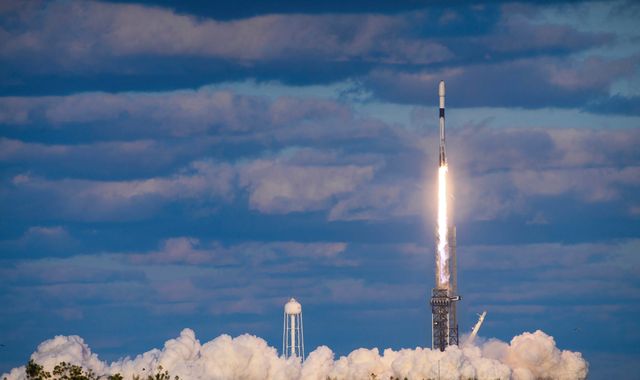US launches another spy into orbit - here's what we know about the hundreds of satellites watching us
9 April 2024, 14:59 | Updated: 9 April 2024, 18:52

The US launched a reconnaissance satellite into orbit on Tuesday, the second reconnaissance satellite to go up in as many days.
On Monday, South Korea sent its second into space, after the first went up in December. The country has a contract with SpaceX to send up three more reconnaissance satellites by 2025.
North Korea sent up its own in November and at the end of March, a North Korean official said the nation expects to launch several more reconnaissance satellites this year.
Leader Kim Jong Un has vowed to launch three additional military spy satellites in 2024.
So what are all those satellites doing up there?
Gaining military advantages
The National Reconnaissance Office in the US says it "uses satellites and other space-based capabilities to secure and expand America's intelligence advantage".
"Some of the earliest satellites were reconnaissance satellites," Professor Erik Gartzke, the director of the Center for Peace and Security Studies at the University of California, told Sky News.
"During the Cold War, they allowed the Soviets and the United States to make arms control agreements that were enforceable because each side could see if the other side was cheating.
"Largely because of this technology, it became possible to have some of the first and most effective arms control agreements in world history."
The UK has its own network of 'Beyond Line of Sight communications' called Skynet.
They are make sure the UK armed forces "get the right information at the right time," according to Airbus, who runs the network.
These reconnaissance satellites are also being used to fight crime.
In 2021, Colombia's notorious drug lord Otoniel was captured using satellite imagery analysed by experts from the UK, US and elsewhere.
North and South Korea have been more explicit about what their satellites are for.
Disputed pictures of the Pentagon
In November, North Korea's leader Kim Jong Un said the country's satellites would "deter, control and manage the dangerous and aggressive moves of hostile forces", according to state media.
When the country's first satellite successfully went into orbit, North Korea claimed it was transmitting imagery of key sites in the US and South Korea, including the White House and the Pentagon.
But it hasn't released any of those satellite photos, and foreign experts doubt whether the North Korean satellite can transmit militarily meaningful imagery.
Whether the country even had control of the satellite was disputed until researchers verified signs from the satellite in February.
Read more from Sky News:
Prototype could pave the way for constant energy all the time - from space
Astrocomb breakthrough could help discover Earth-like planets
Moon to get its own time zone created by NASA - but clocks work differently there
Bolstering the 'kill chain'
Until December 2023, South Korea had no spy satellites of its own and was reliant on the US to monitor moves by North Korea.
With two South Korean satellites now in orbit, the military says its powers have been improved.
"Our military has acquired an additional independent surveillance ability and further bolstered our 'kill chain' capability," a defence ministry spokesperson told reporters.
The 'kill chain' capability refers to the ability to preemptively fire missiles.
But Professor Gartzke says these satellites could decrease military conflict.
"As more countries get this capability or have access to it, the effectiveness of defence will increase, which will mean it's harder to invade your neighbour," he said.
Satellites are changing warfare.
Hannibal is often considered one of the great military strategists, partly because he surprised his enemies.
When Russian forces began amassing on Ukrainian borders, satellites made sure the world was able to watch.
(c) Sky News 2024: US launches another spy into orbit - here's what we know about the hundreds of satellites watching us

























